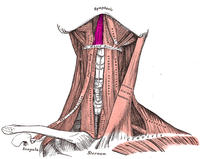
Photo from wikipedia
BACKGROUND It has not yet been clarified how the type of the chewing task affects related muscle activity and how the suprahyoid muscles contribute to masticatory function in humans. OBJECTIVES… Click to show full abstract
BACKGROUND It has not yet been clarified how the type of the chewing task affects related muscle activity and how the suprahyoid muscles contribute to masticatory function in humans. OBJECTIVES This study aimed to investigate the difference in the suprahyoid muscle activity between the freely and unilaterally chewing tasks and between the working and non-working sides during chewing. MATERIALS AND METHODS Twenty healthy volunteers were instructed to chew peanuts and two different types of rice crackers in two ways; freely and unilaterally while surface electromyograms of the masseter and suprahyoid muscles were recorded. The chewing duration, number of chewing cycles and chewing rate were compared between the tasks. Further, the masseter and suprahyoid muscle activities per chewing cycle were compared between the sides. RESULTS The chewing duration was significantly longer and the chewing rate was significantly higher during unilaterally chewing than freely chewing. The chewing duration differed significantly among the different foods; the harder the food, the longer the duration. Chewing rate was significantly higher during soft rice cracker chewing as well as suprahyoid activity per chewing cycle. Masseter activity was higher on the chewing side than on the non-chewing side while there was no difference in suprahyoid activity between the sides. CONCLUSION The current results demonstrate a difference in the masticatory efficacy between the chewing tasks and a functional role of the suprahyoid muscles during chewing, which does not differ between the chewing and non-chewing sides.
Journal Title: Journal of oral rehabilitation
Year Published: 2022
Link to full text (if available)
Share on Social Media: Sign Up to like & get
recommendations!